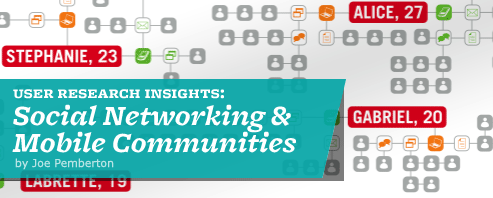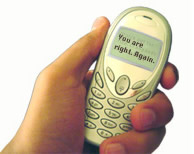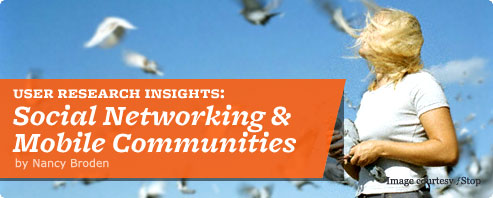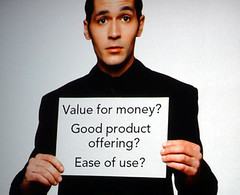
Today at the EuroIA Summit, Barcelona, we will discuss insights from the Punchcut-funded mobile social networking study.
The poster lists the chief insights and provides a visualization of the users ages and their behaviors (text messaging, IM, email, photo sharing, blogging, commenting both using desktop apps and mobile devices).
Continue Reading »
Add this to digg, del.icio.us, etc.
This iPhone tip goes out to those of you following the growing “Life Hacks” movement - gaining back precious minutes of your life through efficiency practices.
We’ve all been stuck in meetings that we wish we could get out of. Well, fortunately His Steveness has designed something handy into the iPhone which will help us reclaim our lives so we can get back to doing what we _really_ want to be doing. If you have the foresight, try this before attending your next meeting:From the main menu, select Clock then Timer. Use the wheel interface to set your interval (How much of this meeting are you willing to endure?), set your ringtone and hit “Start.”
Attend your meeting. Go ahead and shut your phone down (read as: Hit the hardware button on top right) and set it on the table next to your notebook, printouts, etc. and act as interested as you can in the meeting. Resist the urge to check the timer - don’t worry, it won’t let you down. When the timer reaches zero, it will wake up your iPhone and play the ringtone. To anyone glancing over at your iPhone, the combination of idle screen wallpaper and ringtone will look convincing, even to a fellow iPhone user.
Grab it shortly into the first ring, give it a quick glance, and apologize to those left in the room.. “Sorry, I gotta take this…”
Add this to digg, del.icio.us, etc.
A couple of insightful posts have surfaced about Nokia’s worldwide research. The first on BBC News is an interview with Jan Chipchase, Nokia Design’s principal researcher. I first heard Chipchase talk about his work at the DUX 2005 conference in San Francisco. I came away knowing he has, hands down, the coolest job around.
Continue Reading »
Add this to digg, del.icio.us, etc.


Fiona Carswell, a graduate of the Interactive Telecommunications Program at New York University, has the answer to your text message doldrums.
“CELL STICKIES: For people who go to great lengths to see what they want to see, Cell Stickies is a small booklet of translucent sheets with comforting messages printed on them. Not satisfied with the text message you received? Peel off a Cell Sticky and slap it on your cellphone screen, showing you the message you really wanted to see.”
Add this to digg, del.icio.us, etc.
 MEX CONFERENCE, LONDON — Paul Kompfner, Head of Development for ERTICO spoke in response to the following MEX manifesto point:
MEX CONFERENCE, LONDON — Paul Kompfner, Head of Development for ERTICO spoke in response to the following MEX manifesto point:
“The world is gaining embedded intelligence. The mobile industry faces a fundamental user experience challenge to make handsets as effective as communicating with the environment as they are with other humans. We think the connection of millions of machines to wireless communication networks represents the most significant generational change since the introduction of packet data.”
Imagine this: As you approach your vehicle, technology in your mobile phone interfaces with the car. It authenticates and unlocks for you. The seats, mirrors, radio stations adjust to your presets as you settle into the vehicle.
You start the car without need for a key. Your media in your device syncs with the larger capacity and capability of the vehicle. As you rocket down the highway listening to a favorite podcast, a call comes in. The volume reduces and you’re able to press a key on your steering wheel to take the call, never having had to take your eyes off the road.
Suddenly carrying around a device in our hand feels only mildly mobile. How does a user’s needs change when moving down a highway at 100mph? The automobile is the next frontier for the mobile user experience. Getting the experience right can mean the difference between life and death.
Continue Reading »
Add this to digg, del.icio.us, etc.

Social networking and user-generated content are, without a doubt, hot topics in the mobile sector right now. The marriage of social networking and mobile phones seems logical: our mobile phones are always with us and keep us connected to our networks all day, every day. We currently use our mobile phones to create and share content to a limited degree, and as our devices become more and more sophisticated the kinds of user-generated content we create and the means by which we share them will only increase. In anticipation of this wave, Web-based social networking sites like MySpace are moving into mobile hoping to increase their reach and popularity, while the ranks of startups are swelling with developers of wireless social networks or tools that facilitate mobile social networking. 3’s See Me TV in the UK has already shown that that video created and consumed on the mobile phone can be a popular proposition.
Despite the growing numbers of players in the mobile social networking space, questions abound about what constitutes a successful mobile social networking experience. What form will social networks take in the mobile context? How will desktop-based and mobile social networks co-exist, or will they? As a San Francisco-based interface strategy, design and development consultancy with a specialization in mobile, we at Punchcut spend a great deal of time pondering these questions and envisioning future-forward solutions for our clients. In order to inform our design efforts, we recently conducted a qualitative study of the social networking behaviors of 11 young adults living in the San Francisco Bay area. The purpose of the study was to gain an understanding of why young, socially connected individuals engage in social networking behaviors and how the use of a mobile device supports and fosters these behaviors.
Continue Reading »
Add this to digg, del.icio.us, etc.
Scott Weiss, the author of Handheld Usability (the book and blog), recently posted the results of a survey of over 800 New Yorkers on the importance of several factors when considering the purchase of a new phone. Weiss notes that the survey respondents value mobile ease-of-use 3 to 2 over appearance. “The finding is astounding, because it shatters the commonly-held believe that appearance is more important to consumers than usability”, he writes. After ease-of-use respondents considered appearance, internet access, MP3 player capabilities and mobile television features, in that order. Weiss adds, “the highest percentage of respondents (33%) rated Mobile Television Features and MP3 Player Capabilities as Neither Important nor Unimportant in their mobile phone purchase decisions”.
While I agree with his ultimate conclusion — that usability is a big deal and ease-of-use should be a goal of all handset manufacturers — I question drawing that conclusion based on the survey information provided.
Continue Reading »
Add this to digg, del.icio.us, etc.

This month, Google Labs released a new service called GOOG-411. A toll-free call will get you in touch with a friendly, natural-sounding robot asking you for your city, your listing or category, and then offer to connect you, give you address details, or send all those goodies to your phone via text message. The voice recognition is impressive and the overall flow is fairly speedy, though there are certainly redundancies that lengthen the overall process for the sake of usability (which in this case earns them points in my book). Luckily, there’s a cheat sheet for advanced users to blast past some of the menus.
GOOG-411 is a clever development effort on Google’s part as all of this infrastructure — maps, text messaging, business directory search — is already part of the Google suite of services and this mashup recipe sets them up with a solid core experience. Building on this service is only a matter of choosing which pieces will add to the user experience and not overly complicate its current simplicity. For example, I can easily imagine saying “Directions” and having step-by-step instructions of how to get there from where I am while leveraging my phone’s location data.
Continue Reading »
Add this to digg, del.icio.us, etc.
If you think Tamagotchi is past tense for virtual pet, think again. They’re connecting with some US partners to create a competitor to Disney Mobile and Firefly.
“Tamagotchi virtual pet now comes as just one of the many features loaded onto a fully functional prepaid mobile phone for kids. The phone is being brought to retail through a joint effort between PlayPhone and Bandai America Inc.”
Summary:
- It’s aimed at kids, duh

- The handset is brightly colored and comes with a preloaded Tamagotchi mobile game and a custom Tamagotchi wallpaper
- It’s a no-contract, pay-as-you-go handset
- It comes with parental controls that parents will be able to limit dialing access for incoming and outgoing calls and lock the push-to-talk and Web access capabilities.
- Ability to convert users’ prepaid airtime minutes into mobile content credits to spend on additional wallpapers, games, and Ringtones on the TamaPhone.com Website – thus avoiding the use of a credit card.
Read more information at: http://www.collectiondx.com/node/147
Add this to digg, del.icio.us, etc.

EMI keynote at CTIA Orlando
Eric Nicoli (CEO of EMI Group) hinted in his keynote at CTIA that his company had been “experimenting” with DRM-free music and said that their studies showed people would be willing to pay more for it. Last weeks’EMI Group announcement of an iTunes deal will make higher quality, DRM-free, tunes available for $1.29. The new offering doesn’t replace the existing $.99 DRM versions. What’s even more user-friendly is that users who own DRM versions can upgrade their tracks for $.30 each.
 Eric Nicoli also made a call for the mobile industry, specifically those in the media and entertainment realm, to take cues from Apple and address issues like value for price, making compelling products and ease of use.
Eric Nicoli also made a call for the mobile industry, specifically those in the media and entertainment realm, to take cues from Apple and address issues like value for price, making compelling products and ease of use.
Add this to digg, del.icio.us, etc.







 Eric Nicoli also made a call for the mobile industry, specifically those in the media and entertainment realm, to take cues from Apple and address issues like value for price, making compelling products and ease of use.
Eric Nicoli also made a call for the mobile industry, specifically those in the media and entertainment realm, to take cues from Apple and address issues like value for price, making compelling products and ease of use.